| Title | Image | Summary of text |
|---|---|---|
| Mancy - Without - Page 51 | 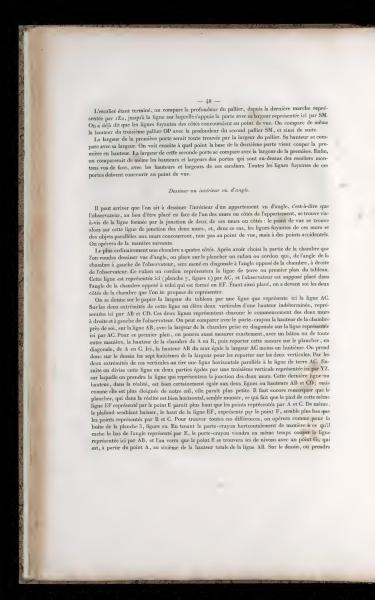 | The text discusses comparing the dimensions of doors and landings using perspective, highlighting how vanishing lines converge at the viewpoint. It then explains how to draw a room interior from an angle by positioning an observer diagonally and using reference points for accurate representation. Emphasis is given to measuring and transferring dimensions accurately in perspective drawing. |
| Mancy - Without - Page 52 |  | The text describes methods for determining points and drawing accurate lines to represent a room's interior in perspective. It explains how to find points E and F using a drawing tool and discusses the relationships between various line segments, angles, and vanishing points. The explanation includes detailed instructions for drawing a door in perspective related to wall measurements, using a pencil holder as a measuring guide. |
| Mancy - Without - Page 53 | 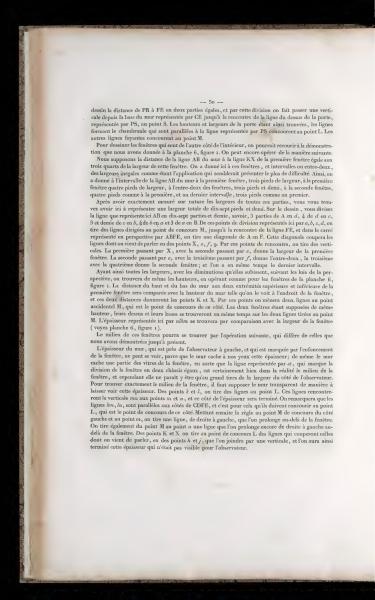 | This text describes the method for dividing a wall's distance and determining the placement of windows in perspective drawing. Instructions are given for calculating the widths and heights of parts based on specific proportional divisions. The procedure for determining precise dimensions, using parallel and converging lines, is explained in detail for accurate representation using plates and points as references. |
| Mancy - Without - Page 54 |  | The text is a detailed guide on how to draw architectural perspectives of windows and galleries. It explains using perspective lines and geometrical calculations to ensure accurate proportions and positioning of elements in drawings. The instructions emphasize using certain points of reference and measuring distances to create realistic architectural renderings. |
| Mancy - Without - Page 55 |  | The text describes a method for determining dimensions and drawing geometrically correct depictions of pillars and their components, such as capitals, using specific mathematical ratios and geometrical techniques. It explains how to use geometrical and perspective planes to understand and depict elements in drawing, utilizing the example of a box figure from a reference plate. The instructions include measuring and comparing angles, dimensions, and lines to achieve accurate perspective representations, with a focus on practical execution techniques for artists. |
| Mancy - Without - Page 56 | 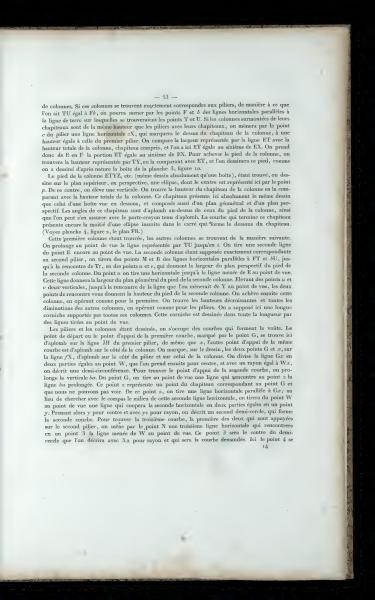 | The text describes the alignment and drawing of columns and their capitals in perspective, ensuring they match specific measurements and relationships with pillars. The first column is used as a basis to replicate the others, with detailed instructions on extending lines and matching dimensions to achieve precision in their depiction. The description also involves constructing vaults above these columns using semicircles and horizontal lines to ensure the correct architectural representation. |
| Mancy - Without - Page 57 |  | The text details a method to draw a staircase from the side view, using a series of geometrical and perspective techniques. It explains how to measure and set dimensions for each step, highlighting the proportional methods required for accurate depiction. The description includes instructions on how to align lines to a viewpoint and compose parallels to outline the staircase profile. |
| Mancy - Without - Page 58 |  | The text discusses the principles of drawing landscapes from nature, emphasizing the importance of comparing the sizes of objects to the largest dimension in a composition. It specifically addresses drawing a landscape as seen through a window, detailing how to frame and position the observer relative to the window. The method involves careful measurement and comparison to ensure faithful reproduction of the landscape. |
| Mancy - Without - Page 59 |  | This text describes the method of dividing a window's width and height into equal sections to analyze perspective and distance using points of convergence in a drawing. It explains the procedure to draw open window shutters and suggests techniques for comparing lengths and angles with a protractor. The lesson further includes steps for drawing objects, towers, and terrains using perspective to match observed shapes and dimensions on a drawing. |
| Mancy - Without - Page 60 |  | The text provides instructions for positioning a drawing subject relative to a grid seen through a window, using methods explained in earlier plates. It details how to compare the height and width of natural elements with the grid's dimensions to draw landscapes directly from nature. It also introduces techniques for selecting and representing an engaging portion of a landscape using a small frame of reference. |
| Mancy - Without - Page 61 |  | The text elaborates on the use of an instrument intended for determining a painting’s field of view, also referring to artistic concepts such as perspective and depth. It describes how to use the instrument to define the limits of a tableau, emphasizing the need for proper distancing in landscape art to ensure accurate representation. Additionally, it covers guidelines for comparing dimensions and adjusting positions to maintain spatial relationships within a composition. |
| Mancy - Without - Page 62 |  | The text discusses methods of finding and comparing points and distances in drawing from nature. It describes techniques to measure and compare heights and widths of objects in landscapes and buildings using reference points and comparisons with trees and mountains. Additionally, it explains the concept of reflections in water, where the surface acts like a mirror reflecting objects placed at its edge, maintaining the same size as the objects reflected. |
| Mancy - Without - Page 63 | 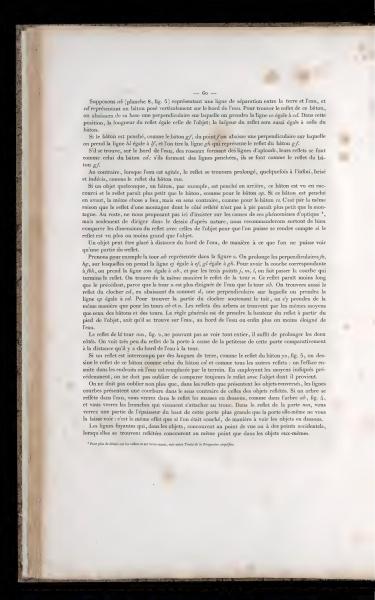 | The text explains methods to determine the reflection of objects like sticks and towers on water, considering their position and orientation. It provides detailed instructions on how to calculate the length and direction of reflections, using perpendiculars and comparing sizes. The text includes notes on perspective and optical phenomena related to reflections. |
| Mancy - Without - Page 64 |  | The text discusses basic concepts of aerial perspective, focusing on shadows and how light affects them. It explains how objects appear smaller and less distinct as they move away due to the transparent air filling the space between planes. The passage emphasizes the importance of accurately depicting shadows and details to maintain the natural depth and realism of a painting. |
| Mancy - Without - Page 65 |  | The text discusses how atmospheric conditions affect how far and clearly one can see, impacting the perception of landscape details. It provides guidance on how to shade landscapes when drawing, emphasizing the use of contrasts and the effects of different planes and reflections. Techniques for drawing through a window or in open fields are also explained, using sticks or other markers to compare tones and perspectives. |
| Mancy - Without - Page 66 |  | The text provides guidance on understanding shadow and light in drawings. It discusses how different lighting and shading techniques affect the perception of objects in art, suggesting methods for beginners. It also describes the effects of light and shadow on both rounded and angular objects, offering advice on how to sketch effectively using various drawing tools. |
| Mancy - Without - Page 67 |  | The text explains how shadows are lengthened or shortened based on the sun's position relative to the horizon. Shadows are shortest at noon and longer during sunrise and sunset. There's also a note indicating the end of the first and second segments or parts of the book. |
| Mancy - Without - Page 68 |  | The text discusses the principles of drawing the head either from life or using a bust as a model. It emphasizes accuracy and fidelity to nature, with a methodical approach to proportions and the drawing of different head positions. The text is divided into three sections focusing on overall head structure, proportion details, and drawing head features. |
| Mancy - Without - Page 69 |  | The text discusses a drawing method emphasizing drawing from real objects rather than copying drawings, starting with simple shapes before progressing to the human head. It critiques the traditional approach of starting drawing practice with facial features and promotes a natural progression, ensuring the student understands perspectives and proportions. Additionally, it outlines a technique for constructing an oval shape for head drawings, explaining the operations necessary for different head positions. |
| Mancy - Without - Page 70 |  | The text details methods for drawing ovals representing a face viewed from different angles: front and three-quarters. Steps include dividing vertical lines and using arcs to shape an oval, likening parts to egg form. The instructions emphasize the process of forming outlines and contours of a head, with specific geometric guidance for artists. |
| Mancy - Without - Page 71 |  | The text provides instructions on drawing the mass of a head viewed in profile from a bust or nature. It details the positioning of the observer, the measurement of dimensions for accurate representation, and finding the inclination or movement of the head. It includes guidance on using tools to determine and compare various dimensions and angles. |
| Mancy - Without - Page 72 |  | The text provides a detailed method for measuring and drawing a bust, highlighting specific points on the model and correlating them with a diagram. It describes how to align parts of the model with specific lines and dimensions, ensuring proportions remain consistent. The author offers guidance on observing a bust from different angles and suggests techniques for ensuring accurate representation in drawings. |
| Mancy - Without - Page 73 |  | The page discusses methods for drawing human head proportions, focusing on lines of operation and geometrical constructions. It explains using vertical lines to determine the inclination and alignment of facial features, specifically addressing how to proportion the face into equal parts. Additionally, it describes calculating the width of shoulders and their height relative to the neck, ensuring symmetrical representation in drawings. |
| Mancy - Without - Page 74 |  | The text discusses the practical applications of studying head proportions from both ancient sculptures and nature when learning to draw. It addresses a common objection, emphasizing that while classical proportions provide a foundation, understanding natural variations is key to capturing the likeness of diverse subjects. The importance of recognizing unique facial characteristics and applying these observations to achieve resemblance in drawings is highlighted. |
| Mancy - Without - Page 75 |  | The text outlines a method for drawing the head in profile, focusing on dividing the head into equal parts to properly position facial features like the nose, mouth, and eyes. Various lines and points are described to maintain correct proportions, serving as operation lines that guide the drawing process. Detailed instructions ensure that the dimensions for features such as the mouth and ear follow the established proportional relationships. |
| Mancy - Without - Page 76 |  | The text explains the proportions and positioning of facial features and head angles in drawing. It details how certain features, like the neck and eyebrow, relate in size and alignment, including considerations for different head positions. The guidance includes observations on how the head's inclination affects the lines of operation used in drawing. |
| Mancy - Without - Page 77 |  | The text discusses the method of dividing the human head into sections and drawing operational lines for an accurate artistic representation. These guidelines vary depending on the head’s angle, such as when tilted to the side, affecting how features like the nose, mouth, and eyes appear. It also explains the use of tools like a pencil holder for drawing curved lines and discusses the importance of foreshortening in creating realistic perspectives. |
| Mancy - Without - Page 78 |  | The text describes the method for dividing the head's proportions when viewed from the front, focusing on places of key facial features like the mouth and eyes. The guide uses specific measurements, with the head divided into four equal parts vertically and provides proportional details for features like the mouth and nose. It includes technical instructions on drawing these features accurately, emphasizing the importance of straight lines and proportions in achieving a true representation. |
| Mancy - Without - Page 79 | 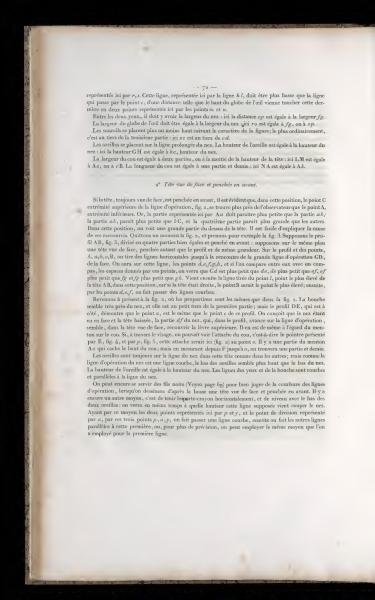 | The text describes the proportions and positioning of facial features when viewed from the front and tilted forward. Key aspects discussed include the distances and sizes of the eyes, nose, and ears relative to each other, with guidelines for accurately portraying these elements. Methods for judging line curvatures when drawing a head positioned this way are also detailed. |
| Mancy - Without - Page 80 | 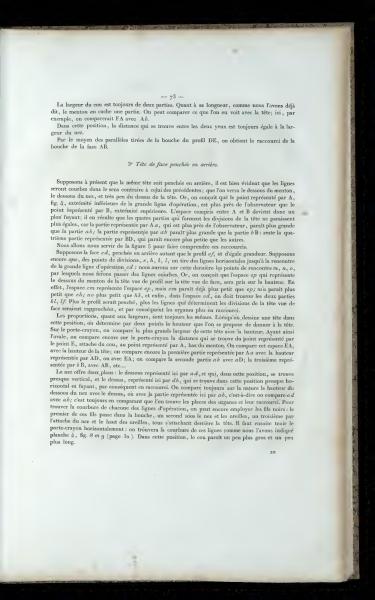 | This text explores the proportions and foreshortening of the head and face when viewed from different angles, such as the head tilted backward. It describes how the divisions of the head change when viewed from the front and discusses specific anatomical features like the neck, eyes, and nose positioning. Techniques for drawing these features using parallels, operational lines, and comparisons are also provided. |
| Mancy - Without - Page 81 |  | The text discusses the proportions and positioning of a head in a three-quarters view, where the head is seen from an angle between profile and face-on. It explains the proportions of the facial features and how they change perception compared to other views. The document provides specific measurements to maintain accuracy in representations of the head at this angle. |
| Mancy - Without - Page 82 |  | The text discusses the proportions of a child's head compared to an adult's, with a focus on profile and front views. It explains how the dimensions and placements of facial features like the nose, eyes, and mouth differ. The sections include detailed comparisons and measurements, emphasizing the more rounded shapes in children's heads. |
| Mancy - Without - Page 83 |  | This text provides instructions on drawing a child’s head from various angles, focusing on proportion and measurement. It describes how to determine proportions of facial features—such as the mouth, ears, and eyes—by comparing them to other parts like the nose and chin. The passage also gives instructions on using diagrams and recommends tools for achieving precision. |
| Mancy - Without - Page 84 |  | This section discusses the external structure and position of the eyes. The text explains how the eyes are suspended and directed by muscles, and how the eyelids function to protect the eyes from light. Details about the eyelids' positioning and their impact on the eye's visibility in different positions are also covered. |
| Mancy - Without - Page 85 |  | This text describes the visual changes in the representation of the eye from different perspectives, such as full face, profile, and three-quarters view. It explains how the visibility and shape of the iris and pupil change with these angles, and how eyelid thickness affects the appearance of the eye. The document also discusses measurements and proportions needed to accurately depict these variations in drawings. |
| Mancy - Without - Page 86 |  | The text explains how to depict an eye from different angles, including profile and frontal views, focusing on how the pupil, iris, and eyelashes appear. It emphasizes that the perceived position where the eyelashes converge changes based on the observer's view. The text highlights various positions of the eye as looking upwards, downwards, and closed, detailing the changes observed in the eyelids and eye muscles. |
| Mancy - Without - Page 87 |  | The text describes the proportions and measurements of the nose when viewed from the front, detailing how its width relates to its height. It also explains the methods for accurately capturing these dimensions and angles when drawing, considering variations in head inclination. Additionally, the text covers the proportions of a nose when viewed at a three-quarter angle, emphasizing the consistent relationship between width and height. |
| Mancy - Without - Page 88 | 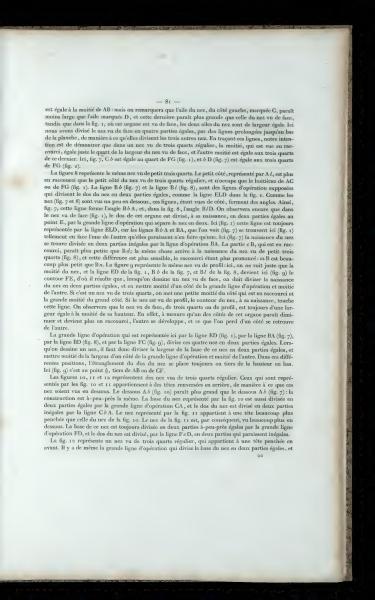 | The discussed text explains the geometric visualization of drawing noses in various perspectives, including the front, three-quarters, and profile views. It details how different lines divide the nose's width and base into proportional parts, essential for achieving accuracy in rendering noses from distinct angles. It describes the adjustment of these measurements depending on the view and the head's tilt in different illustrations. |
| Mancy - Without - Page 89 |  | The text discusses techniques for drawing the nose and mouth in different positions and angles. It refers to proportions and guidelines, such as using lines to divide facial features accurately. The concept of modeling or shaping the nose and mouth is emphasized, along with specific figures referenced for examples. |
| Mancy - Without - Page 90 |  | The text explores the structure and proportions of the mouth from various perspectives, particularly focusing on the differences between seeing a mouth from the front, three-quarters, and profile. It discusses the lines of operation and how they change based on the mouth's orientation, with detailed examinations of the upper and lower lips. The latter part describes various expressions and their impact on the shape and orientation of the mouth. |
| Mancy - Without - Page 91 | 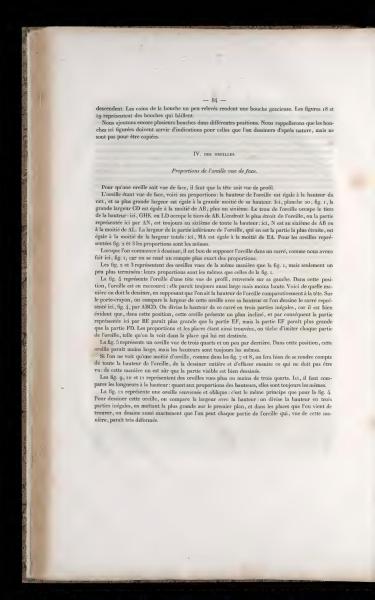 | This text explains drawing the human ear, focusing on viewing and portraying ear proportions accurately. It provides instructions on depicting ears from different angles, including from the front and profile, and how to understand dimensions by conceptualizing them within geometric shapes. The explanations emphasize the importance of comparison between various parts and using foreshortening techniques when needed. |
| Mancy - Without - Page 92 |  | The text describes the method for drawing the human body from nature or a plaster cast, starting with studying proportions. It outlines three sections of study: the proportions of figures, movement and gravity, and sketching techniques for the figure's mass. The approach is explained through dividing the body into eight equal parts for proportional accuracy. |
| Mancy - Without - Page 93 |  | This text explains the proportions of the human body using the head as a unit of measure. It details the relative lengths and widths of different body parts in terms of head lengths, both from front and profile views. The method aids in studying and verifying human anatomical proportions using a scaled approach. |
| Mancy - Without - Page 94 |  | The text discusses the proportional differences between figures seen from the back and front, stressing how the ideal beauty proportions can vary due to foreshortening. The document also compares the physical proportions of men and women, noting that while heights are similar, widths vary slightly, with men generally having longer waists. The passage provides a detailed explanation of comparing parts of the body in terms of head lengths for better artistic accuracy. |
| Mancy - Without - Page 95 | 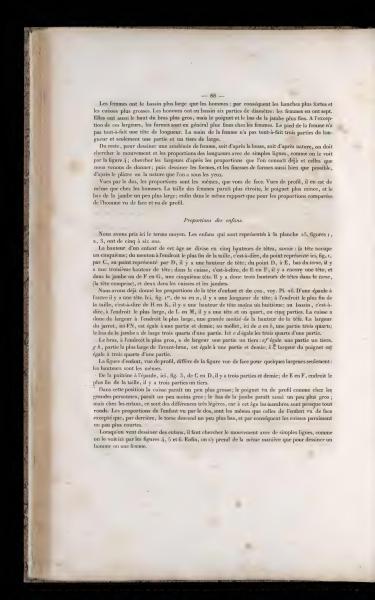 | The text discusses the differences in body proportions between women and men, noting broader hips and finer limbs in women. A section provides guidelines on how to draw these differences. Another section describes the proportions of children, dividing a child's height into segments relative to the size of the head, providing detailed instructions on drawing these features from different angles. Emphasis is on using simple lines to capture movement and proportions effectively. |
| Mancy - Without - Page 96 |  | The text discusses two types of body movements: hinge and rotational, describing where and how these occur in the body. It explains the movements at different joints such as the elbow, knee, wrist, and hips, emphasizing proper understanding to avoid errors in figure drawing. Additionally, it highlights the importance of the center of gravity for balanced and graceful depiction, where understanding its placement enhances the realism and aesthetic of drawn figures. |
| Mancy - Without - Page 97 |  | The text explains the importance of understanding the center of gravity when drawing figures. It discusses different body positions and how they shift weight and balance, emphasizing various experiments to illustrate these points. The method for drawing a figure using vertical and horizontal lines for accurate proportions is also outlined. |
| Mancy - Without - Page 98 |  | The text explains methods for drawing human figures, focusing on proportions and alignment using tools like a pencil holder. It discusses measuring head heights and observing shoulder inclinations, which helps accurately represent body movement and positioning, whether standing, seated, or kneeling. The principles outlined emphasize using a consistent scale of eight head heights and how to adjust for perspective and angles in drawing. |
| Mancy - Without - Page 99 |  | This section discusses the proportions involved in drawing the human hand. It explains that the length of the hand is one-third of the head's length and provides detailed measurements for each finger and segment. The text suggests starting by sketching the basic shape when drawing a hand. |
| Mancy - Without - Page 100 |  | The text discusses the proportions of hands and feet, emphasizing how different perspectives alter their perceived dimensions. It details how to measure and depict these proportions accurately, referencing specific illustrations. Additionally, it explains the division of the foot into three parts and compares the toes' proportions to those of the fingers. |
COPYRIGHT © 2024 STUDY DRAWING. ALL RIGHTS RESERVED.